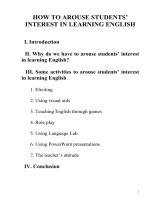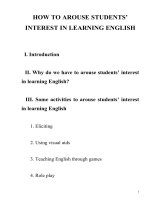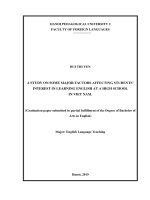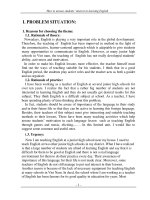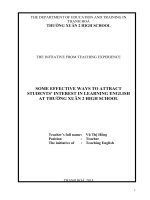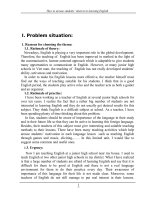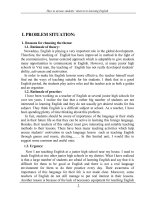Sustaining an Interest in Learning English and Increasing the Motivation to Learn English
Bạn đang xem bản rút gọn của tài liệu. Xem và tải ngay bản đầy đủ của tài liệu tại đây (99.89 KB, 9 trang )
Sustaining an Interest in Learning English
and Increasing the Motivation to Learn
English: An Enrichment Program
Supyan Hussin, Nooreiny Maarof, and J. V. D'Cruz
A persistent problem faced by many English teachers, especially the non-specialists, is the
attempt to sustain genuine interest in continuing to learn English and to use the English
language once the examinations are over. Teachers have to create a healthy balance
between preparing students for the standardized examinations and for life-long language
skills. One solution is to develop a continuous program which includes an integrated in-
class and out-of-class language activities that help nurture student language skills. Within
the program, an environment, which is rich with language input, is thus provided. The
program requires the retraining of in-service teachers who are provided with a framework
within which they can apply new techniques in language teaching. The presenters will draw
upon their experience in conducting a retraining of 77 teachers in Pahang whereby an
enrichment program was introduced. Feedback received from the training group supports
the use of enrichment programs, which make use of on-going activities within the school
English language curriculum..
Introduction
The famous proverb "Don't give your students fish, but teach them how to fish" is perhaps
true in language teaching. But how do we go about teaching them the language skills so
that they become more interested in learning the language? Also how do we maintain their
interest in language learning when English is not seen as important for their immediate
needs other than to pass the examinations?
Often, English language teachers who subscribe to the behaviorist approach to language
teaching adopt the Audiolingual Method (ALM) or Direct Method which focus on forms
and accuracy of the studentsâ output or performance. Thus, many teachers are found
drilling the students with continuous grammatical exercises especially at the primary
school level. Despite exposure to training in the communicative approach, may teachers
still avoid practicing the approach because the communicative component, i.e. oral
communication makes up only ten percent of the exam score on the English test. In other
words, many teachers are more interested in training students how to read and write well in
addition to teaching students to master the grammar component of the language.
Although the drill-and-practice approach has some advantages in language teaching, it
however does not help the students to master the language in the long run. Often, we find
students who become good test-takers, and yet they are not able to speak and write
competently when they graduate from high schools. What is more important is that teachers
realize that given an environment (in rural areas) where the English language input is
limited and non-conducive to learning the target language, teachers need to find creative
ways to teach the language and increase the student's motivation to learn the language and
to eventually appreciate the language. Undoubtedly, possessing some knowledge about
various language teaching methodologies (e.g. ALM, Direct Method, Grammar-
Translation, Suggestopedia, Community language Learning, Natural Approach, Total
Physical Reponses, Communicative method) is crucial, but it is more important for teachers
to know what the most appropriate approach to teaching the language in that particular
environment is and what activities are suitable for a given group of learners.
Based on our general observation of language teaching in schools, at least in the Maran
District schools where we conducted our language teaching workshops, teachers tended to
ignore the importance of such factors as positive self-concept, high self-esteem, positive
attitude, clear understanding of the goals for language learning, continuous active
participation in the language learning process, and the relevance of a conducive
environment that could contribute to the success of language learning. In most cases,
teachers are worried about how to drill the students to obtain high scores on the English
paper in the national examination. The problem for many English teachers, especially the
non-specialists, is how to encourage genuine interest among students to continue to learn
and use the English language once the examinations are over. The question that needs to be
addressed is how do teachers create a healthy balance between preparing students for the
standardized examinations and for life-long language skills.
Motivation
Gardner and Lambert (1972) introduced the notions of instrumental and integrative
motivation. Instrumental motivation refers to the learner's desire to learn a language for
utilitarian purposes (such as employment or travel or exam purposes) in the context of
language learning. On the other hand, integrative motivation refers to the desire to learn a
language to integrate successfully into the target language community. In later research
studies, Crookes and Schmidt (1991), and Gardner and Tremblay (1994) explored four
other motivational orientations: (a) reason for learning, (b) desire to attain the learning
goal, (c) positive attitude toward the learning situation, and (d) effortful behavior.
Many theorists and researchers have found that it is important to recognize the construct of
motivation not as a single entity but as a multi-factorial one. Oxford and Shearin (1994)
analyzed a total of 12 motivational theories or models, including those from socio-
psychology, cognitive development, and socio-cultural psychology, and identified six
factors that impact motivation in language learning:
• Attitudes (i.e., sentiments toward the learning community and the target language)
• Beliefs about self (i.e., expectancies about one's attitudes to succeed, self-efficacy,
and anxiety)
• Goals (perceived clarity and relevance of learning goals as reasons for learning)
• Involvement (i.e., extent to which the learner actively and consciously participates
in the language learning process)
• Environmental support (i.e., extent of teacher and peer support, and the integration
of cultural and outside-of-class support into learning experience)
• Personal attributes (i.e., aptitude, age, sex, and previous language learning
experience)
Based on this brief discussion, we believe that teachers are able to drive the students to
learn the language and to sustain studentsâ interest in language learning if they can provide
activities that are:
• interrelated between in-class and out-of class language activities
• communicative (game type) integrative (short/small activities form larger activities)
• pleasant, safe and non-threatening
• enthusiastic
• group-based
• meaningful or relevant
• challenging
These activities help promote:
• self-confidence
• experiences of success
• learning satisfaction
• good relationships among learners and between teacher and students
An Enrichment Program
Research has shown that factors such as positive learner and teacher attitudes, which are
interrelated to motivation, must be sustained for successful transfer of language learning
(Finocchiaro, 1982; Ngeow, 1998). To foster positive attitudes and to motivate learning, in
particular, the learning of English as a Second Language, an environment conducive to
learning must be created. Factors that help create such an environment include:
• a learning situation that has a "low affective filter" (Krashen, 1987) whereby the
learners learn to use the language in a non-threatening and fun environment.
Otherwise, learners will feel uncomfortable and insecure which will further induce
a "psychological barrier" to communication and learning (Littlewood, 1995)
• providing various types of input which are auditory, visual, sensory, verbal and
non-verbal in nature and input which is comprehensible or a little beyond the level
of the learner ( i + 1)
• providing a continuous and consistent exposure to the language being learned
• an environment where the teachers and the students are supportive and encouraging
• having access to situations wherein students are able to use the language as a
"natural means of communication" (Littlewood, p. 58, 1995)
These factors should be present in any language learning program. The enrichment part of a
language curriculum must encompass these factors which encourage successful transfer
and learning of the target language.
A language enrichment program should not be seen as separate from the school curriculum.
Instead, it needs to complement and strengthen the development of language proficiency of
students in schools. Therefore, what occurs in the language classrooms must be extended
beyond the walls of the classrooms so that a link is created between what is learned in the
classrooms with what occurs outside of the classrooms. A healthy balance has to be created
between the immediate needs of examinations and the long-term needs of communicative
competence. Furthermore, within an enrichment framework other interrelated factors such
as the teachersâ philosophy, theories, and experience of the language; the contemporary
climate of the teaching situation (which is affected by such factors as the political,
economic, and technological advances of the country); the available teaching aids and
materials ; and the constant demand to prepare students for the standardized exams all play
interconnected roles within the school language curriculum (See Appendix A for a diagram
of the framework).
Within the enrichment program, various activities and tasks are prepared which require
active participation of the learners. Some examples of such activities include:
• a reading program with such tasks as writing a synopsis, journal, and compiling
vocabulary lists
• language immersion projects such as language camps and visits
• a specific day or week or month or time and space devoted to the use of the
language such as an English zone, spelling bee competition, story-telling corner,
read-to-me corner, essay and drama competition, poetry reading at the general
assembly, etc.
• a network of people who could provide the constant input of the language such as
pen pals, teacher mentors, conversation partners and so forth
These activities are supported by classroom or school environments that provide simple
strategies to encourage the use of the language such as murals, labels in and around the
school, consistent exposure to language competitions (choral speaking, scrabble, etc.) and
English notice board (interactive in that learners can pose questions or reply to questions).
All these need to be given acknowledgment and recognition in the form of rewards and
encouragement (e.g. prizes, public mention, etc.) to motivate and sustain interest in the use
of the language.
It should be pointed out here that the main emphasis of this enrichment program is more on
the process of learning rather than the performance of learning. It is hoped that a series of
language activities, in-class as well as out-of class, will lead the students to a successful
language acquisition process.
A Report on Our Teacher Training Workshops
The purpose of the teacher training workshops was to exchange ideas and experience as
well as update teachersâ knowledge and skills on language teaching and learning. Some
teachers who have been teaching over a period of time may need to update themselves with
the current teaching-learning trend. Some others, especially, the non-trained teachers, lack
knowledge, skill, and experience and may still need some general exposure on effective
teaching techniques that could be carried out in their schools. The training workshops,
involving 77 English teachers from the Maran District, were conducted in Jengka during
the school holidays. With the help of the Maran Education District Office, the teachers
were selected from several schools to participate in the training workshop.
These workshops were initially meant for teachers who were not English majors and those
who have taught English for less than two years. The teachers were divided into three
groups: primary, lower secondary, and upper secondary. However, because there were not
enough teachers who were not English majors, other English teachers were also asked to
participate. Table 1 shows the academic background of the teachers and Table 2 depicts the
number of years that the teachers had been teaching. A majority had taught for less than 3
years.
Table 1: English Teachers' Academic Qualification
Academic Qualification
Primary
N=29
Lower
secondary
N=23
Upper
secondary
N=25
English/TESL Degree 11 15
Non-English/TESL degree with Dip. Ed.
(English/TESL)
6 4
Non-English/TESL degree 6 4
English/TESL Teaching Certificate 21 2
Non-English/TESL Teaching Certificate 8
Table 2: Years of English Language Teaching Experience
Years
Primary
N=29
Lower secondary
N=23
Upper secondary
N=25
1-3 16 11 14
4-6 6 4 4
7-9 2 2 1
9-11 1 2 3
More than 11 4 4 3
The three workshops, each run consecutively over three days, were fully funded by
Lembaga Kemajuan Wilayah Jengka (LKWJ) or the Jengka Development Authority, a
governmental body responsible for the welfare and the development of the Jengka district
in Pahang. LKWJ has been working hard to raise the educational level and the economic
standards of the Jengka settlers. The majority of the settlers in Jengka grow palm oil and
rubber trees under the government's Federal Land Development Authority (FELDA)
scheme.

